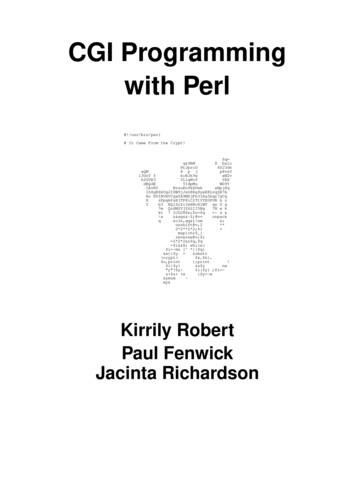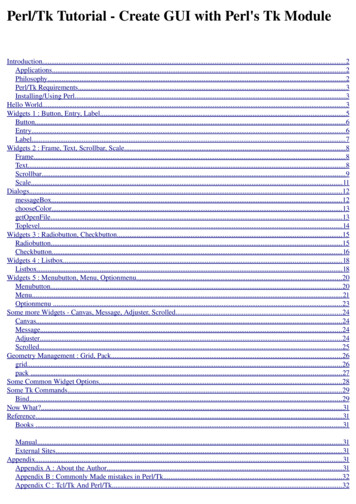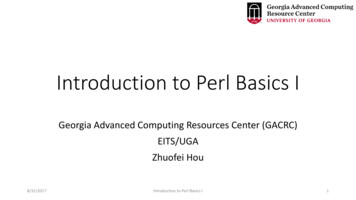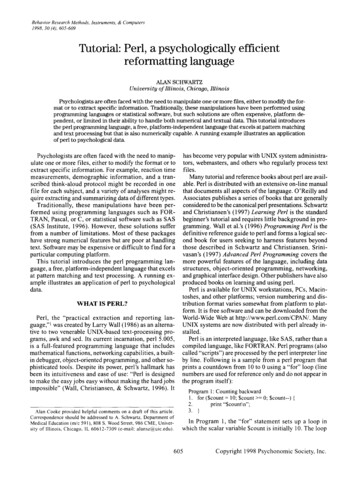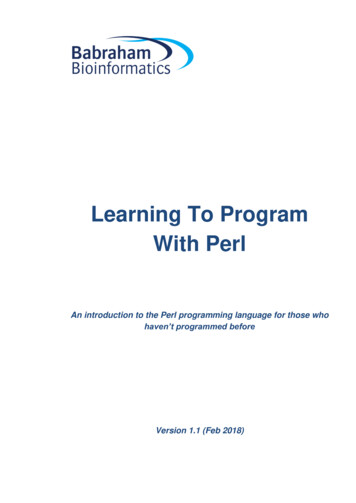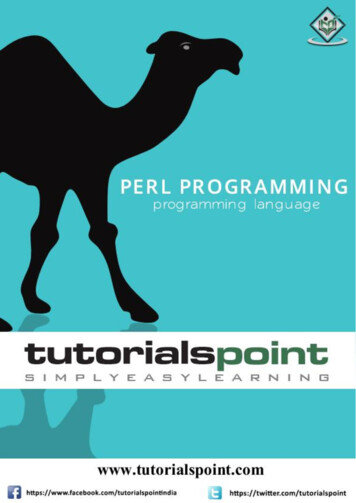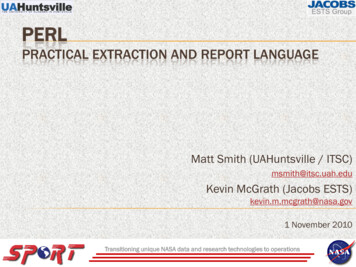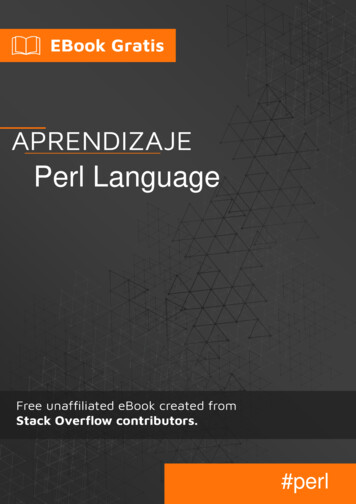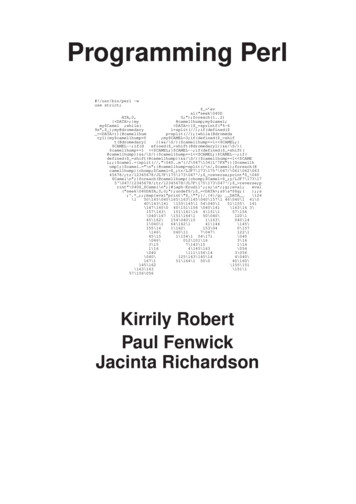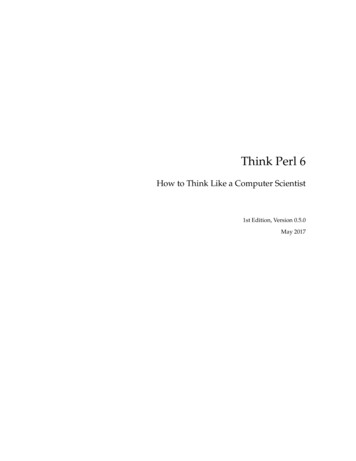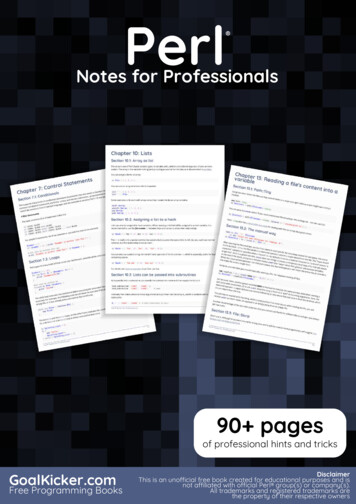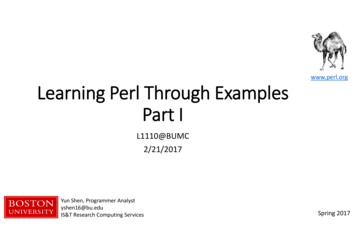
Transcription
Learning Perl Through ExamplesPart Iwww.perl.orgL1110@BUMC2/21/2017Yun Shen, Programmer Analystyshen16@bu.eduIS&T Research Computing ServicesSpring 2017
Tutorial ResourceBefore we start, please take a note - all the codes andsupporting documents are accessible through:www.perl.org http://rcs.bu.edu/examples/perl/tutorials/Yun Shen, Programmer Analystyshen16@bu.eduIS&T Research Computing ServicesSpring 2017
Sign In SheetWe prepared sign-in sheet for each one to signWe do this for internal management and quality controlSo please SIGN IN if you haven’t done soYun Shen, Programmer Analystyshen16@bu.eduIS&T Research Computing Serviceswww.perl.orgSpring 2017
Research Computing Services (RCS) RCS is a group within Information Services & Technology (IS&T) at Boston Universityprovides computing, storage, and visualization resources and services to supportwww.perl.orgresearch that has specialized or highly intensive computation, storage, bandwidth, orgraphics requirements. Three Primary Services:1.2.3. Research ComputationResearch VisualizationResearch Consulting and TrainingMore Info: http://www.bu.edu/tech/about/research/Yun Shen, Programmer Analystyshen16@bu.eduIS&T Research Computing ServicesSpring 2017
Research Computing Services (RCS) TutorialsRCS offers tutorials three times a yearwww.perl.org Spring – in January/Feburary Summer – in May/June Fall – in SeptemberThis Perl tutorial is part I of a set (Part II come tomorrow)Yun Shen, Programmer Analystyshen16@bu.eduIS&T Research Computing ServicesSpring 2017
About MeJoin RCS March 2016long time programmer, dated back in 1987Proficient in C/C /PerlDomain knowledge: Network/Communication, Databases,Bioinformatics, System Integration. Contact: yshen16@bu.edu, 617-638-5851 Main Office: 801 Mass Ave. 4th Floor (Crosstown Building) Yun Shen, Programmer Analystyshen16@bu.eduIS&T Research Computing Serviceswww.perl.orgSpring 2017
Tell Me A bit about You Name Experience in programming? If so, which specific lauguage?Self rating? Experience in Perl? Account on SCC? Motivation (Expectation) to attend this tutorialYun Shen, Programmer Analystyshen16@bu.eduIS&T Research Computing Serviceswww.perl.orgSpring 2017
Topics for todayBackgroundGet to know Perl EnvironmentUsing PerlCode ExamplesPackages and ModulesPerl help systemPerl DebuggerQ&AYun Shen, Programmer Analystyshen16@bu.eduIS&T Research Computing Serviceswww.perl.orgSpring 2017
EvaluationOne last piece of information before we start:www.perl.org DON’T FORGET TO GO TO: http://rcs.bu.edu/survey/tutorial evaluation.htmlLeave your feedback for this tutorial (both good and bad aslong as it is honest are welcome. Thank you)Yun Shen, Programmer Analystyshen16@bu.eduIS&T Research Computing ServicesSpring 2017
www.perl.orgBackgroundYun Shen, Programmer Analystyshen16@bu.eduIS&T Research Computing ServicesSpring 2017
What Is PerlPerl - the most famous backronym rather than an acronym"Practical Extraction and Reporting Language".www.perl.org Developed by Larry Wall in 1987 at System Development Corporation (part ofUniSys later on) originally as a Unix Scripting Language Grown to be a full flown programming language, with many featuresborrowed from other languages, such as C/sh/Lisp/AWK/sed/CGI Perl5 and Perl6 are mostly used nowYun Shen, Programmer Analystyshen16@bu.eduIS&T Research Computing ServicesSpring 2017
Language Design Philosophy “There's more than one way to do it“ design philosophy and multiparadigm, dynamically typed language features leads to great degreeof flexibility in program design.www.perl.org CPAN and Perl Module (175,537 available modules in CPAN in 34,669distributions, written by 12,927 authors, mirrored on 250 servers) CPAN is honored to be called Perl’s ‘killer app’ (seehttps://en.wikipedia.org/wiki/CPAN for more)Yun Shen, Programmer Analystyshen16@bu.eduIS&T Research Computing ServicesSpring 2017
Perl ClassificationPerl 5 and 6 are considered a family of high-level, generalpurpose, interpreted, dynamic programming languages.www.perl.org High-level – syntax/semantics close to natural language General purpose – not limited to specific tasks in a particular applicationdomain Interpreted – relative to compiled language (prepared/checked vs realtime/interactive) Dynamic – not strict in predefined data type constraints, etc.Yun Shen, Programmer Analystyshen16@bu.eduIS&T Research Computing ServicesSpring 2017
Borrowed FeaturesPerl Borrows many features from other programming languageswww.perl.org From C:procedural, variables, expression, assignment ( ), bracedelimited blocks ({}, ;), control flow (if, while, for, do, etc ), subroutine From shell: ‘ ’ sign, system command From Lisp: lists data structure; implicit return value From AWK: hash From sed: regular expressionYun Shen, Programmer Analystyshen16@bu.eduIS&T Research Computing ServicesSpring 2017
Authenic FeaturesPerl’s most authentic features of its own:www.perl.org auto data-typing auto memory management It’s all handled by Perl interpreterThese are very powerful features and contribute a lot to the wide adoption ofPerl languageYun Shen, Programmer Analystyshen16@bu.eduIS&T Research Computing ServicesSpring 2017
Where Perl is used System administrationConfiguration managementWeb sites/web applicationSmall scriptsBioinformaticsScientific calculationsTest automation (the riches lie in CPAN)Yun Shen, Programmer Analystyshen16@bu.eduIS&T Research Computing Serviceswww.perl.orgSpring 2017
Swiss Army Chainsaw or Duct Tape of Internet?Perl gained its nickname of ‘Swiss army chainsaw’ for its flexibility andpower; its ‘Duct Tape of Internet’ for its ability and often ‘ugly’, quick,easy fixes for Internet problems. Commonly referred applications: www.perl.orgPowerful text processing without data length limitationRegular expression and string parsing capabilityCGI (duct tape, glue language for Internet)DBIBioPerlYun Shen, Programmer Analystyshen16@bu.eduIS&T Research Computing ServicesSpring 2017
Major versions Perl 5 – almost rewrite of Perl interpreter, adding object-oriented(OO) feature, complex data structure, module and CGI support.Among them, module support plays critical role to CPAN’sestablishment, and nowadays a great resource and strength for Perlcommunity Perl 6 – fundamentally different from Perl 5, dedicated to Larry’sbirthday, goal is to fix all the warts in Perl 5; it’s said to be good atall that Perl 5 is good at, and a lot more.Yun Shen, Programmer Analystyshen16@bu.eduIS&T Research Computing Serviceswww.perl.orgSpring 2017
Language Scope Perl is highly extensive language Open source framework – CPAN model CPAN and Perl Module 175,537 available modules 34,669 distributions written by 12,927 authors mirrored on 250 serversYun Shen, Programmer Analystyshen16@bu.eduIS&T Research Computing Serviceswww.perl.orgSpring 2017
Language Elements Data Types– scalar, array, hash, reference Control Structures– for, while, if, goto (yes, there is a Goto) Regular Expressions User Defined Extensions (Subroutines and functions) Objects/modules/packagesYun Shen, Programmer Analystyshen16@bu.eduIS&T Research Computing Serviceswww.perl.orgSpring 2017
Advantage Over C Perl runs on all platforms and is far more portable than C. Perl and a huge collection of Perl Modules are free software (eitherGNU General Public License or Artistic License). Perl is very efficient in TEXT and STRING manipulation i.e. REGEXP. It is a language that combines the best features from many otherlanguages and is very easy to learn. Dynamic memory allocation is very easy in PERL, at any point of timewe can increase or decrease the size of the array (i.e. splice(), push())Yun Shen, Programmer Analystyshen16@bu.eduIS&T Research Computing Serviceswww.perl.orgSpring 2017
Disadvantage Over C You cannot easily create a binary image ("exe") from a Perl file. It's not aserious problem on Unix, but it might be a problem on Windows. Moreover, if you write a script which uses modules from CPAN, and want torun it on another computer, you need to install all the modules on thatother computer, which can be a drag. Perl is an interpretative language, so its comparatively slower to othercompiling language like C. So, it’s not feasible to use in Real timeenvironment like in flight simulation system.Yun Shen, Programmer Analystyshen16@bu.eduIS&T Research Computing Serviceswww.perl.orgSpring 2017
Some famous applications Web CGI (EBay, Craigslist, BBC, Amazon, ) 1000 Genome Project Financial analysis (ease of use, speed for integration, rapidprototyping) - BarclaysCapital Summarizing system logs/deal with Windows registry or Unix Passwdor groups fileYun Shen, Programmer Analystyshen16@bu.eduIS&T Research Computing Serviceswww.perl.orgSpring 2017
www.perl.orgGet To Know EnvironmentYun Shen, Programmer Analystyshen16@bu.eduIS&T Research Computing ServicesSpring 2017
Connecting to SCC Option 1: You are able to keep everything you generateUse your Shared Computing Cluster account if you have one.www.perl.org Option 2: all that you do in the tutorial may be wiped out aftertutorial ends unless you move the contents to somewhere belong toyou.We will offer tutorial username and password in the classroomYun Shen, Programmer Analystyshen16@bu.eduIS&T Research Computing ServicesSpring 2017
Download source codeFollow these steps to download the code:www.perl.orgssh tuta31@scc4.bu.edumkdir perlThruExcd perlThruExwget ThruExamples.zipunzip perlThruExamples.zipYun Shen, Programmer Analystyshen16@bu.eduIS&T Research Computing ServicesSpring 2017
Exercise 1 - Where is My PerlTwo commands to use:andwww.perl.org‘which perl’‘perl -v’Do the experiment on next page to help understand the concept anddiscover moreYun Shen, Programmer Analystyshen16@bu.eduIS&T Research Computing ServicesSpring 2017
Exercise 1a - Where is My PerlType ‘which perl’ in terminalwww.perl.orgNow type ‘perl -v’Yun Shen, Programmer Analystyshen16@bu.eduIS&T Research Computing ServicesSpring 2017
Exercise 1b - Where is My PerlType ‘module load perl’, then type ‘which perl’ in terminalwww.perl.orgNow type ‘perl -v’Yun Shen, Programmer Analystyshen16@bu.eduIS&T Research Computing ServicesSpring 2017
Exercise 1 - Observationwww.perl.orgWhat’s the Difference between Exercise 1a and 1b?Yun Shen, Programmer Analystyshen16@bu.eduIS&T Research Computing ServicesSpring 2017
What do we learn from Exercise 1 Perl is an environment – meansit can be changed by pointing to different installations.Yun Shen, Programmer Analystyshen16@bu.eduIS&T Research Computing Serviceswww.perl.orgSpring 2017
Exercise 2 – Perl Program StructureOpen code examples in gedit and browse the content:codeEx simplest.pl and codeEx simplest.pl.nofirstwww.perl.orgTry to run the following commands:./codeEx simplest.pl./codeEx simplest.pl.nofirstWhat happened?Yun Shen, Programmer Analystyshen16@bu.eduIS&T Research Computing ServicesSpring 2017
Exercise 2 – Perl Program Structure (2)Here is what would be:www.perl.orgNow try to run the following command:perl ./codeEx simplest.pl.nofirstWhat happened?Yun Shen, Programmer Analystyshen16@bu.eduIS&T Research Computing ServicesSpring 2017
Exercise 2 – Perl Program Structure (3)Here is what would be this time:www.perl.orgSo why? Why is ‘perl’ in the command so critical to the 2nd codeexample?Topic: Perl program and OSYun Shen, Programmer Analystyshen16@bu.eduIS&T Research Computing ServicesSpring 2017
Exercise 2 – Check Source Codewww.perl.orgYun Shen, Programmer Analystyshen16@bu.eduIS&T Research Computing ServicesSpring 2017
Comments on Exercise 2Comment#1: file name doesn’t matter (.pl is just a convention)Comment#2: file permission doesn’t matter (the file can be in plain readable textpermission)www.perl.orgReason: in the first command, ./codeEx simplest.pl, the file functions as anexecutable (in this case, the executable permission is a must), and inside the script, itmust contains the location for the perl interpreter (which is what the first line of thecode does)But in the second form with perl leading the command: the file functions as mere aninput parameter to feed ‘perl’ command. The true executable from OS point is ‘perl’program itself.Yun Shen, Programmer Analystyshen16@bu.eduIS&T Research Computing ServicesSpring 2017
What do we learn from Exercise 2 Importance of the first line of almost every Perl script (PerlInterpreter is mandatory to be present)www.perl.org This is why the path has to be specified in each Perl script to let thesystem know where to start (this is called ‘Entry Point’)Yun Shen, Programmer Analystyshen16@bu.eduIS&T Research Computing ServicesSpring 2017
www.perl.orgUsing PerlYun Shen, Programmer Analystyshen16@bu.eduIS&T Research Computing ServicesSpring 2017
Command line Option Explained Command format:perl -[v p e i] “perl statement/expression” inputwww.perl.org Options: (type “perl -h” for more options)-e # tell perl to execute some statements in what is quoted following-v # check current perl version-i[extension] # edit input files in place (makes backup if extension supplied)-n # assume "while ( ) { . }" loop around program-p # assume loop like -n but print line alsoYun Shen, Programmer Analystyshen16@bu.eduIS&T Research Computing ServicesSpring 2017
Command line Examples perl -e 'print "Hello World\n"'- same result as run ‘codeEx simplest.pl’ perl -n -e 'print " . - "' codeEx simplest.pl- implicit loop, print code with line number perl -p -n -e ' " . - "' codeEx simplest.pl- implicit loop, implicit print, , using new assignment perl -ne 'print " . - " unless / #/' codeEx simplest.pl- implicit loop, print code with line number perl -ne 'print " . - " if / #/' codeEx simplest.pl- print all lines that are starting with ‘#’Yun Shen, Programmer Analystyshen16@bu.eduIS&T Research Computing Serviceswww.perl.orgSpring 2017
Good Programming Practices Always starts with hash-bang line#!/usr/local/bin/perl Using template/framework to standardize and simplify code tasks(see MyFramework.pl for explanation) Learn to using Perl debugger tool rather than use ‘print’ Start with minimum code required (isolate code) Reduce interference by defining good interfaces through subroutines Pay attention to format (especially with statement across multilines) Many more (refer to ‘Perl Best Practice’)Yun Shen, Programmer Analystyshen16@bu.eduIS&T Research Computing Serviceswww.perl.orgSpring 2017
Good Programming Practices Code Examplewww.perl.orgYun Shen, Programmer Analystyshen16@bu.eduIS&T Research Computing ServicesSpring 2017
Variable Scope What is scope? The space that something is seen/valid Two types of scope: Global vs. Lexical Global variable – visible in the entire package, ‘our’ keyword lexical variable – only visible in the context, with ‘my’ keyword Override: Inside variable overrides(hides) the outside variable Package independence - same variable name can be used in differentpackages, they are totally independent and won’t affect each other Use namespace to provide specificity – use “package::variable”qualifierYun Shen, Programmer Analystyshen16@bu.eduIS&T Research Computing Serviceswww.perl.orgSpring 2017
Variable Scope Example 1www.perl.orgYun Shen, Programmer Analystyshen16@bu.eduIS&T Research Computing ServicesSpring 2017
Variable Scope Example 2www.perl.orgYun Shen, Programmer Analystyshen16@bu.eduIS&T Research Computing ServicesSpring 2017
Variable Scope Example 3www.perl.orgYun Shen, Programmer Analystyshen16@bu.eduIS&T Research Computing ServicesSpring 2017
Variable Scope Good Practicewww.perl.orgTo avoid ambiguity – avoid using same name for different variables unless you are surethey are meant to be same thing ; use meaningful names for each variableYun Shen, Programmer Analystyshen16@bu.eduIS&T Research Computing ServicesSpring 2017
Special Symbols Also called ‘pre-defined variables’ in perldoc Can be divided into five categories: General Variables Regular Expression Variables Filehandle Variables Error Variables State Variables Perl programming depends highly on using these special symbols(variables, more officially). So it is good to know about them. Use ‘perldoc perlvar’ to read the help documentationYun Shen, Programmer Analystyshen16@bu.eduIS&T Research Computing Serviceswww.perl.orgSpring 2017
Special Symbols - General ARG/ – default input space@ARG/@ – parameter array for subroutinewww.perl.org a – small number in sort(); b – large number in sort()%ENV – environment variables%INC – the paths to be searched Yun Shen, Programmer Analystyshen16@bu.eduIS&T Research Computing ServicesSpring 2017
Special Symbols – Regular Expression 1, 2, - matching groups in the parentheses in patternwww.perl.orgOutput:Yun Shen, Programmer Analystyshen16@bu.eduIS&T Research Computing ServicesSpring 2017
Special Symbols – Regular Expression (2) &/ { MATCH} – last successful matching string / { PREMATCH} – the string preceding the last matching string ’/ { POSTMATCH} – the string following the last matching stringYun Shen, Programmer Analystyshen16@bu.eduIS&T Research Computing Serviceswww.perl.orgSpring 2017
Special Symbols – File handlers AGRV – name of current file@ARGV – command line argumentsARGV – special file handle for command line filenames . – current line number / - input line delimiter \ - output line delimiter % - current page numberYun Shen, Programmer Analystyshen16@bu.eduIS&T Research Computing Serviceswww.perl.orgSpring 2017
Special Symbols – File handlers @ ! E ?Perl error stringError number from C, ‘errno’Extended OS error info, such as ‘CDROM tray not closed’Exit status from last processYun Shen, Programmer Analystyshen16@bu.eduIS&T Research Computing Serviceswww.perl.orgSpring 2017
www.perl.orgCode ExamplesYun Shen, Programmer Analystyshen16@bu.eduIS&T Research Computing ServicesSpring 2017
Walk Through Code ExamplesExamples To walk through: (code examples are in ./code/session1/)www.perl.org1. bio nts trans.pl - example in real world to show regular expression in use2. bio prot trans.pl – example in real world to show hash structure in useLet’s go to the terminal to go through these examples now.Yun Shen, Programmer Analystyshen16@bu.eduIS&T Research Computing ServicesSpring 2017
www.perl.orgPackages and ModulesYun Shen, Programmer Analystyshen16@bu.eduIS&T Research Computing ServicesSpring 2017
Purpose of Packages/Modules To address the complicity of software functionality, when single scriptis not sufficient and clear to provide the service.www.perl.org It’s a way to organize codeYun Shen, Programmer Analystyshen16@bu.eduIS&T Research Computing ServicesSpring 2017
What is Package ‘package’ – the term used for functionality, means a division of globalnamespace; can be spread across several files (modules); It’s a logical unit for code functionality; Declares the BLOCK or the rest of the compilation unit as being in thegiven namespace (Perldoc definition) Package Namespace (simplified) Way Perl uses to implement ‘class’ (object-oriented)Yun Shen, Programmer Analystyshen16@bu.eduIS&T Research Computing Serviceswww.perl.orgSpring 2017
What is Module ‘module’ – a library file consists of a set of related methods; It can be used as ‘class’ definition or class implementation , or both(for example: Bio::SeqIO) modules are actual physical libraries stored in file system toimplement desired functioning system the common practice is to organize them by their logical namespaces(package)Yun Shen, Programmer Analystyshen16@bu.eduIS&T Research Computing Serviceswww.perl.orgSpring 2017
Package vs Module - relationship Modern design of perl modules – one module one package object-oriented hierarchically origanized, so outer namespace could cover theinner namespace, to provide modularity Module file directory reflects namespace hierarchy well defined interfaces between modules (namespaces); Two Examples, Bio::DB and Bio::SeqIOwww.perl.orgBio::DB – no common interface; every sub namespace is self-referencedBio::SeqIO – has common abstract interface defined (implemented), whileinside every sub namespace related to certain SeqIO may refer to this commoninterfaceYun Shen, Programmer Analystyshen16@bu.eduIS&T Research Computing ServicesSpring 2017
BioPerl on SCCThis is the first level file structure of BioPerl installed on SCC:www.perl.orgfor full library structure, refer to : doc/bioperl structure.txtYun Shen, Programmer Analystyshen16@bu.eduIS&T Research Computing ServicesSpring 2017
www.perl.orgPerl help systemYun Shen, Programmer Analystyshen16@bu.eduIS&T Research Computing ServicesSpring 2017
Perl Language Reference This is the ultimate resource of authority – BLUEPRINT of a language;www.perl.org Access entrance: http://perldoc.perl.org/index-language.html May be found too difficult to be understood for beginnersYun Shen, Programmer Analystyshen16@bu.eduIS&T Research Computing ServicesSpring 2017
‘perldoc’ utility Embedded Perl documentation system in ‘POD’ (Plain Old Documentation) format Mostly written for Perl library modules:www.perl.orgperldoc perldoc # how to use perldocperldoc perlintro # perl introduction for beginnersperldoc perltoc # Perl table of contentsperldoc perl # overview of Perlperldoc perlfunc # Full list of Perl functionsperldoc -f print # help on built-in function called ‘print’perldoc perlop # full list of perl operatorsmany more (http://perldoc.perl.org/perl.html )Yun Shen, Programmer Analystyshen16@bu.eduIS&T Research Computing ServicesSpring 2017
l.orgYun Shen, Programmer Analystyshen16@bu.eduIS&T Research Computing ServicesSpring 2017
‘man’ command Linux ‘man’ command can be used to access perl module help, forexample:www.perl.orgman perlman perldocman perltocman perlre ‘perldoc’ is recommended over ‘man’ – ‘man’ depends on if the manpages are installed for certain Perl Modules or notYun Shen, Programmer Analystyshen16@bu.eduIS&T Research Computing ServicesSpring 2017
Get Help – online .com/www.perl.orgBooks: (for more refer to perlbook /http://docstore.mik.ua/orelly/perl/cookbook/Yun Shen, Programmer Analystyshen16@bu.eduIS&T Research Computing ServicesSpring 2017
www.perl.orgPerl debuggerYun Shen, Programmer Analystyshen16@bu.eduIS&T Research Computing ServicesSpring 2017
perl -d Use ‘perl –d scriptname’ to start debugger Perl debugger is a fully integrated part to Perl interpreter, that means code mustfirst pass the compiling process to be able to use debugger Frequently used debugger commands:www.perl.orgh: type the help informationn: execute next statements: single step executionr: start/restart/continue run the codeb: set breakpointsv: view source code in the contextYun Shen, Programmer Analystyshen16@bu.eduIS&T Research Computing ServicesSpring 2017
Data::Dumper Perl module commonly used to print out the variable structure andvalue; but more convenientwww.perl.org Usage:use Data::Dumper qw(Dumper);print Dumper \@an array;print Dumper \%a hash;print Dumper a reference;Yun Shen, Programmer Analystyshen16@bu.eduIS&T Research Computing ServicesSpring 2017
Data::Dumper Code Examplewww.perl.orgYun Shen, Programmer Analystyshen16@bu.eduIS&T Research Computing ServicesSpring 2017
www.perl.orgQ&AYun Shen, Programmer Analystyshen16@bu.eduIS&T Research Computing ServicesSpring 2017
Option 2: all that you do in the tutorial may be wiped out after tutorial ends unless you move the contents to somewhere belong to you. We will offer tutorial username and password in the classroom www.perl.org Yun Shen, Programmer Analyst yshen16@
